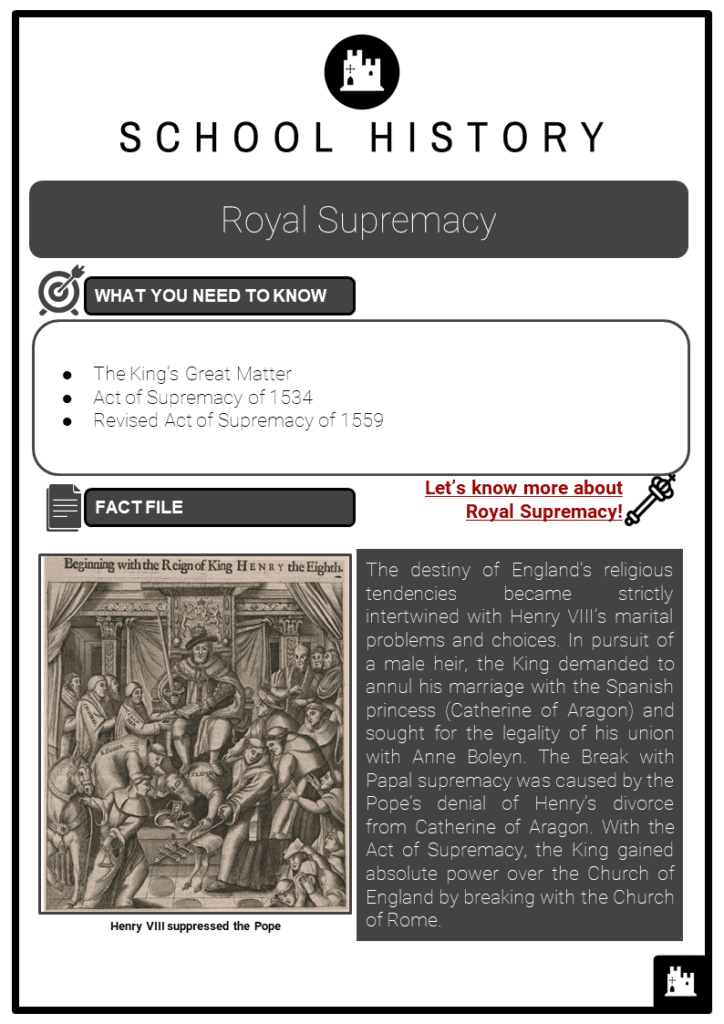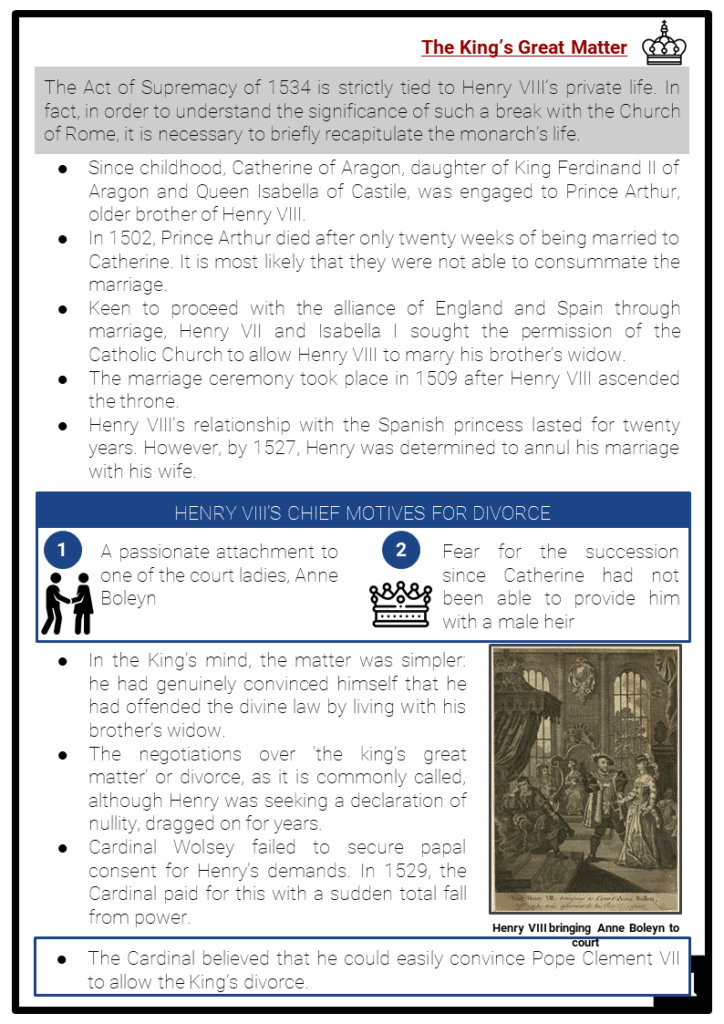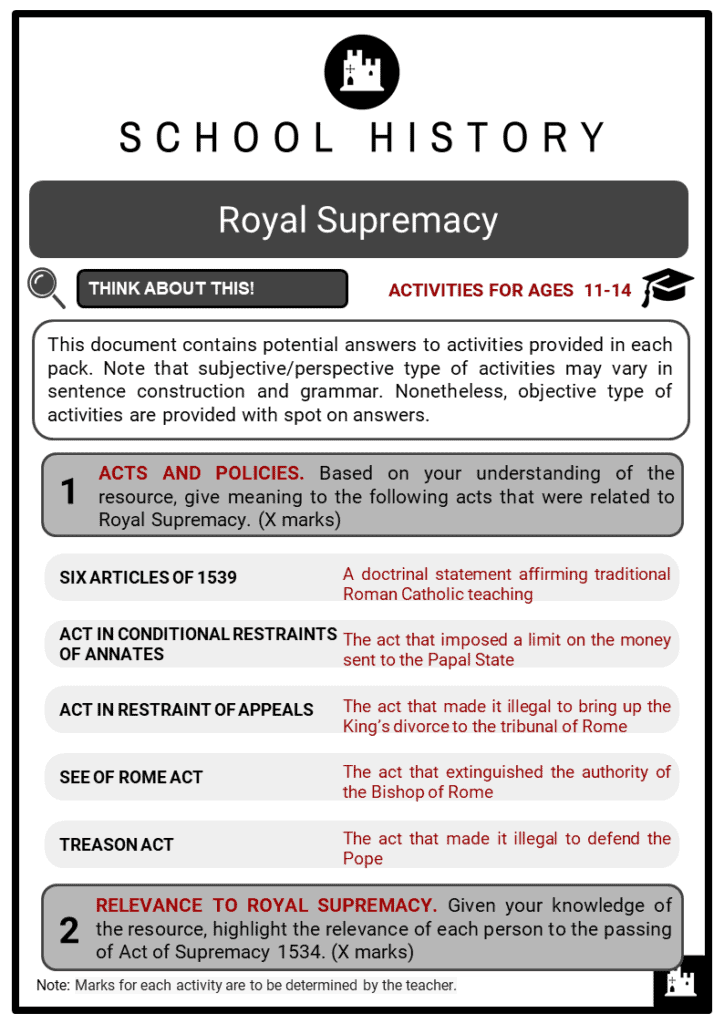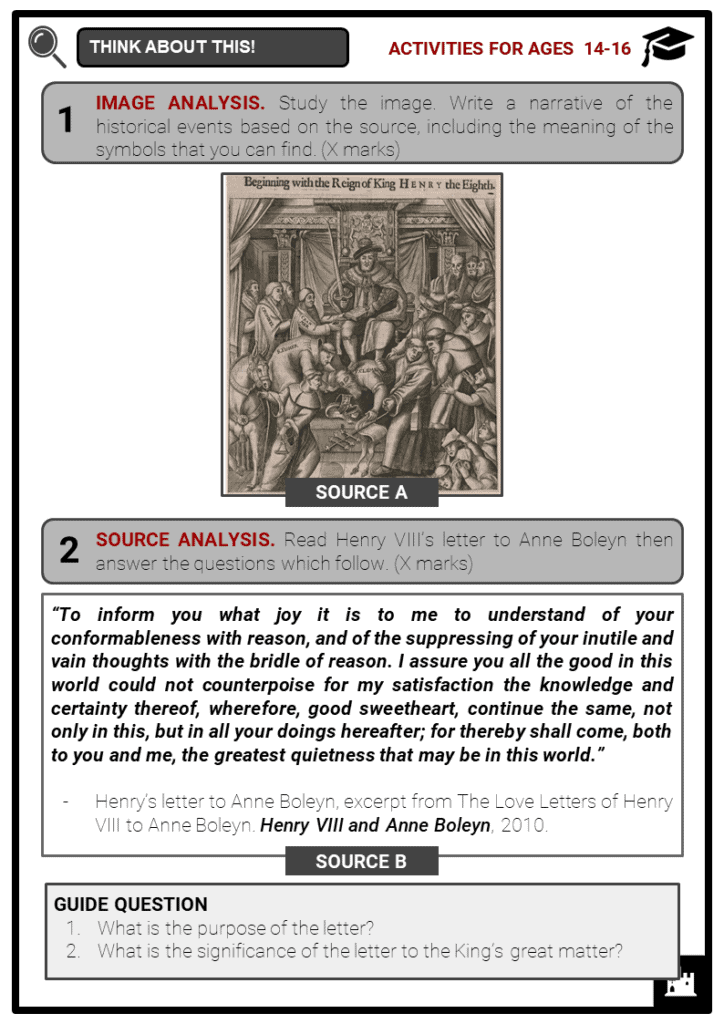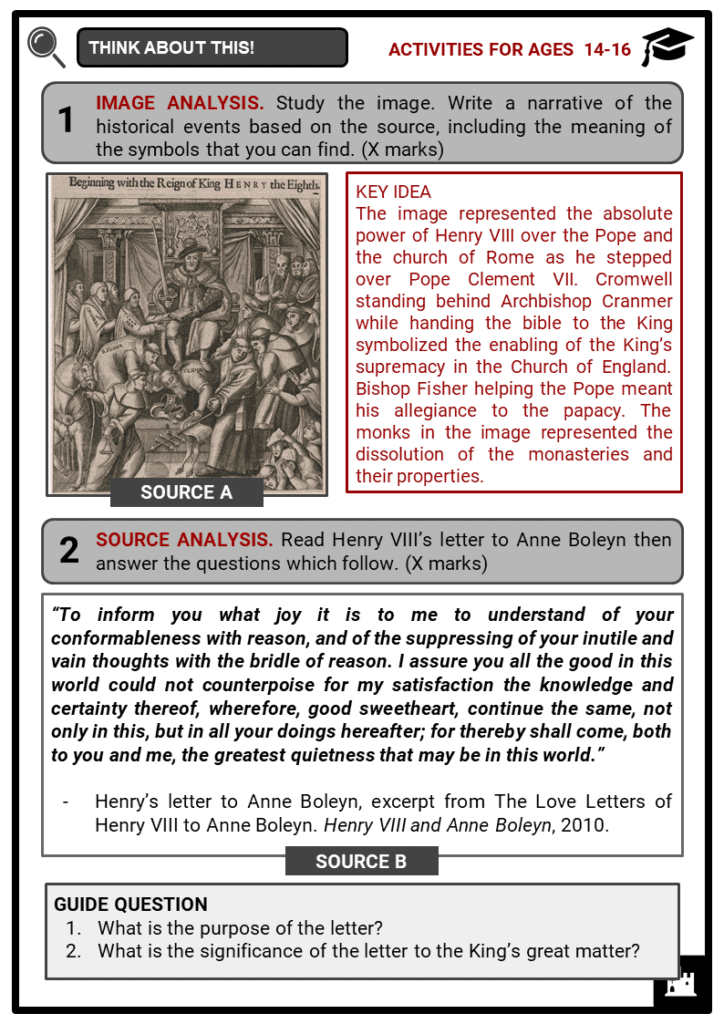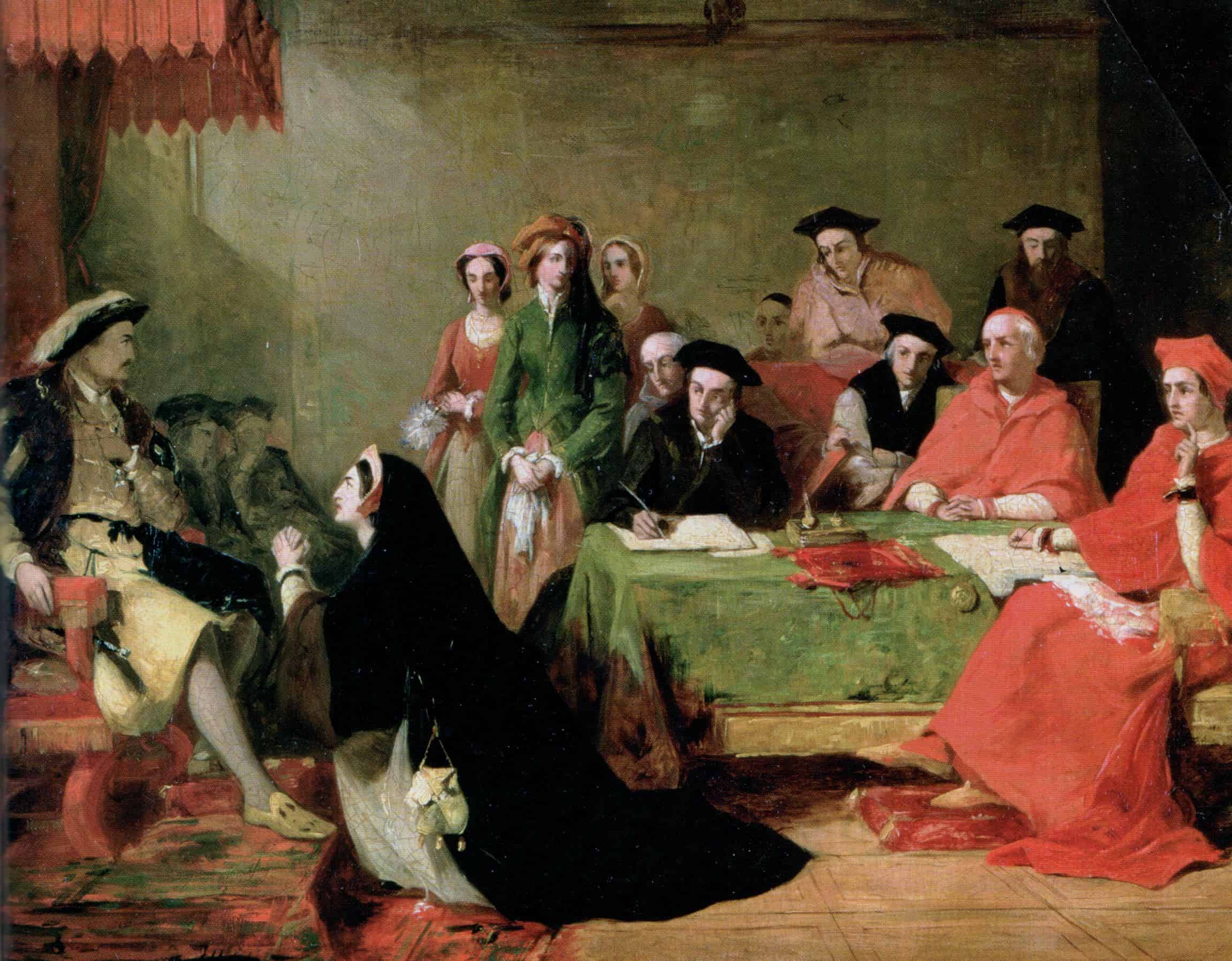Download Royal Supremacy Worksheets
Do you want to save dozens of hours in time? Get your evenings and weekends back? Be able to teach Royal Supremacy to your students?
Our worksheet bundle includes a fact file and printable worksheets and student activities. Perfect for both the classroom and homeschooling!
Table of Contents
Add a header to begin generating the table of contents
Summary
- The King’s Great Matter
- Act of Supremacy of 1534
- Revised Act of Supremacy of 1559
Key Facts And Information
Let’s know more about Royal Supremacy!
- The destiny of England’s religious tendencies became strictly intertwined with Henry VIII’s marital problems and choices. In pursuit of a male heir, the King demanded to annul his marriage with the Spanish princess (Catherine of Aragon) and sought for the legality of his union with Anne Boleyn. The Break with Papal supremacy was caused by the Pope’s denial of Henry’s divorce from Catherine of Aragon. With the Act of Supremacy, the King gained absolute power over the Church of England by breaking with the Church of Rome.
The King’s Great Matter
- The Act of Supremacy of 1534 is strictly tied to Henry VIII’s private life. In fact, in order to understand the significance of such a break with the Church of Rome, it is necessary to briefly recapitulate the monarch’s life.
- Since childhood, Catherine of Aragon, daughter of King Ferdinand II of Aragon and Queen Isabella of Castile, was engaged to Prince Arthur, older brother of Henry VIII.
- In 1502, Prince Arthur died after only twenty weeks of being married to Catherine. It is most likely that they were not able to consummate the marriage.
- Keen to proceed with the alliance of England and Spain through marriage, Henry VII and Isabella I sought the permission of the Catholic Church to allow Henry VIII to marry his brother’s widow.
- The marriage ceremony took place in 1509 after Henry VIII ascended the throne.
- Henry VIII’s relationship with the Spanish princess lasted for twenty years. However, by 1527, Henry was determined to annul his marriage with his wife.
HENRY VIII’S CHIEF MOTIVES FOR DIVORCE
- A passionate attachment to one of the court ladies, Anne Boleyn
- Fear for the succession since. Catherine had not been able to provide him with a male heir.
- In the King’s mind, the matter was simpler: he had genuinely convinced himself that he had offended the divine law by living with his brother’s widow.
- The negotiations over ‘the king’s great matter’ or divorce, as it is commonly called, although Henry was seeking a declaration of nullity, dragged on for years.
- Cardinal Wolsey failed to secure papal consent for Henry’s demands. In 1529, the Cardinal paid for this with a sudden total fall from power.
- The Cardinal believed that he could easily convince Pope Clement VII to allow the King’s divorce.
- The cardinal’s successors did not do any better.
- Despite many criticisms against Rome’s obstinacy (itself compelled by Catherine’s nephew, Charles V, who wished to protect his aunt’s interest), by the end of 1531, it seemed that the King had met with defeat.
- But Henry’s determination never wavered, and a new policy, associated with the greatest statesman of his reign, Thomas Cromwell, brought success by throwing off the pope’s authority altogether and creating a national church in England under the supreme headship of the King himself.
- Henry’s own archbishop, Thomas Cranmer, then divorced him from Catherine.
- In the years 1533-1534, the political state of the English Reformation was achieved with the assistance of a managed but far from subservient Parliament.
- In effect, the King was granted with papal power in England. In 1521 he had written the book Assertio Septem Sacramentorum in which he had praised the Pope and denounced Luther’s views. In gratitude, the Pope bestowed upon the King the title “Defender of the Faith”.
- Whilst Henry had not planned the spread of reformed ideas in religion in his realm, the break with Rome started the questioning of Catholic practices and became the beginning of Protestant England.
- In the end, hostility towards Rome inevitably placed England in alliance with the Pope’s other enemies.
- The dissolution of the monasteries in 1536 to 1540 – the transfer of a fifth of the country’s landed wealth to new hands – may have assisted the growth of Protestantism, but it was undertaken almost solely because the gentry wanted the lands.
- The dissolution of the monasteries played its part in provoking the great northern rising of 1536-1537, known as the Pilgrimage of Grace, the only real threat to the King in all his reign.
- Religious uniformity was achieved with the adoption of a doctrinal statement affirming traditional Roman Catholic teaching called the Six Articles of 1539, and a careful holding of the balance between extreme factions after 1540.
- The reign witnessed changes and moved away from conservative beliefs when the defenders of Catholicism, including Thomas More and John Fisher, had refused to swear an oath and accept the reforms and had died on the scaffold for their loyalty to the papacy in 1535.
- Anne Boleyn had managed to produce only a daughter, the future Queen Elizabeth I.
- Anne Boleyn’s execution in May 1536 on charges of adultery, incest, sorcery, and treason, coupled with the death of Catherine freed Henry for an unquestionably lawful marriage.
- In 1536, he chose Jane Seymour. Following Seymour, Henry VIII also married Anne of Cleves, Katherine Howard, and Catherine Parr.
Act of Supremacy of 1534
- The Act of Supremacy of 1534 underlined the King’s temporal and spiritual power within the kingdom.
- Albeit the king’s majesty justly and rightfully is and ought to be supreme head of the Church of England and so is recognised by the clergy of the realm in their convocations; yet nevertheless for corroboration and confirmation thereof and for increase in virtue in Christ’s religion within the realm of England, and to repress and uproot all errors, heresies and other enormities and abuses heretofore used in the same, be it enacted by authority of this present Parliament that the king our sovereign lord, his heirs and successors kings of the realm shall be taken, accepted and reputed the only supreme head on earth of the Church of England called Anglicana Ecclesia and shall have and enjoy annexed and united to the imperial crown of this realm as well the title and style thereof, as all honours, dignities, pre-eminences, jurisdictions, privileges, authorities, immunities, profits and commodities to the said dignity of supreme head of the same Church belonging and appertaining.
- And that from time to time to visit, repress, redress, reform, order, correct, restrain, and amend all such errors, heresies, abuses, offences, contempts, and enormities whatsoever they be, which by any manner [of] spiritual authority or jurisdiction ought or may lawfully be reformed, repressed redressed, ordered, corrected, restrained, or amended, most to the pleasure of Almighty God the increase of virtue in Christ’s religion and for the conservation of the peace, unity, and tranquillity of this realm, any usage, custom, foreign laws, foreign authority, prescription or any other thing or things to the contrary hereof notwithstanding.
- This act was not to be seen independently: although it represented the act that put an end to England’s relations with the Church of Rome, it must nonetheless be seen in a larger context, where other acts and policies also played a fundamental role.
- When in 1529 Clement VII denied the King’s divorce with Catherine of Aragon, defining it as a lawful and sacred union, Henry VIII worked progressively towards the diminishing of the papal power.
- In fact, he was able to do so by passing laws in Parliament between 1529 and 1536.
- This period in Parliament was called the Reformation Parliament.
- The new laws affected the nation and religion, and it can be said that they were made with the intention of pressuring the pope and limiting the revenue that came from England.
- In March 1532, the Act in Conditional Restraint of Annates imposed a limit on the money sent to the Papal State, and the amount was reduced by 95%.
- Annate is the first year's profits of a Catholic benefice, as traditionally paid directly to the Pope.
- Moreover, when the King divorced from Catherine, he ensured that nobody could appeal to a foreign court by releasing the Act in Restraint of Appeals, which made it illegal to bring up Henry’s divorce to the tribunal of Rome.
- The Act of Supremacy was passed only when the Church of Rome showed no interest in changing their views.
- In 1536, the See of Rome Act put an end to Britain’s relationship with the Papal church.
- It extinguished the authority of the Bishop of Rome and incriminated the Bishop, deeming him responsible for depredations and for the impoverishment of the kingdom through the collection of agnates and other church taxes.
- With the Treason Act, it also became illegal to defend the Pope.
- Defending the Pope would have resulted in high treason, and priests and other members of the clergy were obliged to take an oath in which they renounced the Pope’s authority.
Revised Act of Supremacy of 1559
- The Act of Supremacy of 1534 was repealed under the reign of Mary I.
- The only child of Henry VIII and Catherine of Aragon, Mary I attempted to reverse the English Reformation and return the English church to Roman jurisdiction.
- This meant that the Act of Supremacy of 1534 was repealed and the Heresy acts were revived.
- After Mary’s five-year reign, Elizabeth I succeeded to the English throne.
- When her Parliament convened and passed Henry VIII’s Act of Supremacy, it was widely rejected by the Catholic majority. Thus a revised version of the act was passed in 1559.
- The Act of Supremacy of 1559 narrowed the definition of what constituted heresy and obliged any person taking public or church office in England to swear allegiance to the monarch as Supreme Governor of the Church of England.
Image sources:
[1.] https://farm4.staticflickr.com/3210/2780852695_f0107a9665.jpg

